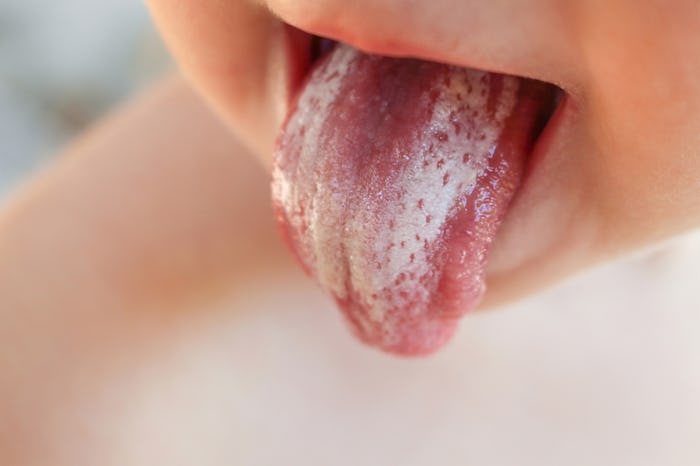Life

Thrush Is Common, But Here's What Science Knows About How Babies Actually Get It
Parenting is one of those things where you learn a lot on the job because there's no instruction manual that comes with babies (unfortunately), and through the course of parenting, you're often faced with a ton of confusion. Infant feeding, breastfeeding, sleep, development, and growth are among the things you encounter within baby's first year, and that doesn't even factor in the possible illnesses or medical issues. Illnesses in babies can be a trying experience, and some of the more common ones, like thrush, are often confusing to identify. So how do babies get thrush? And what is it exactly?
Thrush is a very common yeast infection in babies, according to Kids Health. It's caused by an overgrowth of yeast called candida. Most people, including babies, have a natural amount of yeast in their mouths and digestive tracts, which is considered normal. Its growth is usually controlled by a healthy immune system and "good" bacteria in your body. If your immune system is weakened or undeveloped (like in babies), this yeast can overgrow and cause an infection, like oral thrush (in the mouth), vaginal yeast infection, or diaper rash.
There is no real, identifiable cause for thrush, according to the website for Dr. Sears. But it can sometimes be brought on by using antibiotics (often to treat a bacterial infection). Since antibiotics work by killing bacteria, even the "good" bacteria, yeast is left to grow unchecked, causing it to often overgrow.
A baby with oral thrush might have cracked skin around their mouths, and white patches on their lips, tongue, or inside of their mouths, noted Kids Health. It may look a little bit like leftover milk, but usually can't be wiped away. It may even turn red or irritated when you try to clean it. Some babies may not feed well or are uncomfortable when sucking because their mouth feels sore, but some babies don't feel any pain or discomfort at all.
In breastfeeding mothers and babies, thrush can be passed back and forth from baby's mouth to mother's breast, and the yeast can start to infect the skin around your nipples, the website for Dr. Sears mentioned. It usually starts off mild, but can cause serious pain, especially when nursing. If your nipples are sore, red, itchy, or burning, or if you have deep, shooting breast pain, it could be thrush.
Thrush can also present as a diaper rash in babies — it's usually identified by a stubborn, red, raised rash with red spots, and can accompany oral thrush.
Your pediatrician will be able to diagnose thrush by examining your child and their symptoms. Your primary care provider would be able to do the same for you if you suspect thrush on your nipples. Thrush is typically treated by antifungal creams or antibiotics, depending on the location and severity of the infection, according to the American Academy of Pediatrics (AAP).
Most thrush infections are better within two weeks. But, as noted by the AAP, thrush is prone to be chronic, and reccurences are very common. It's important to be vigilant about staying on top of it, particularly if you or your baby are more suseptible to getting thrush.
Probiotics (like acidophilus) can help sustain the good bacteria in you and your baby's mouth and gut, especially during a course of antibiotics. Talk to your doctor more to understand how this works, and if it is an option for your family. Sterilizing bottle nipples, pacifiers, and any toys that baby chews on can help to kill the yeast residing on them, and sterilizing regularly can prevent it from returning. Keeping your baby's skin as dry and clean as possible, particularly their diaper area, can help to prevent thrush infections, as well.
Check out Romper's new video series, Romper's Doula Diaries:
Watch full episodes of Romper's Doula Diaries on Facebook Watch.
This article was originally published on